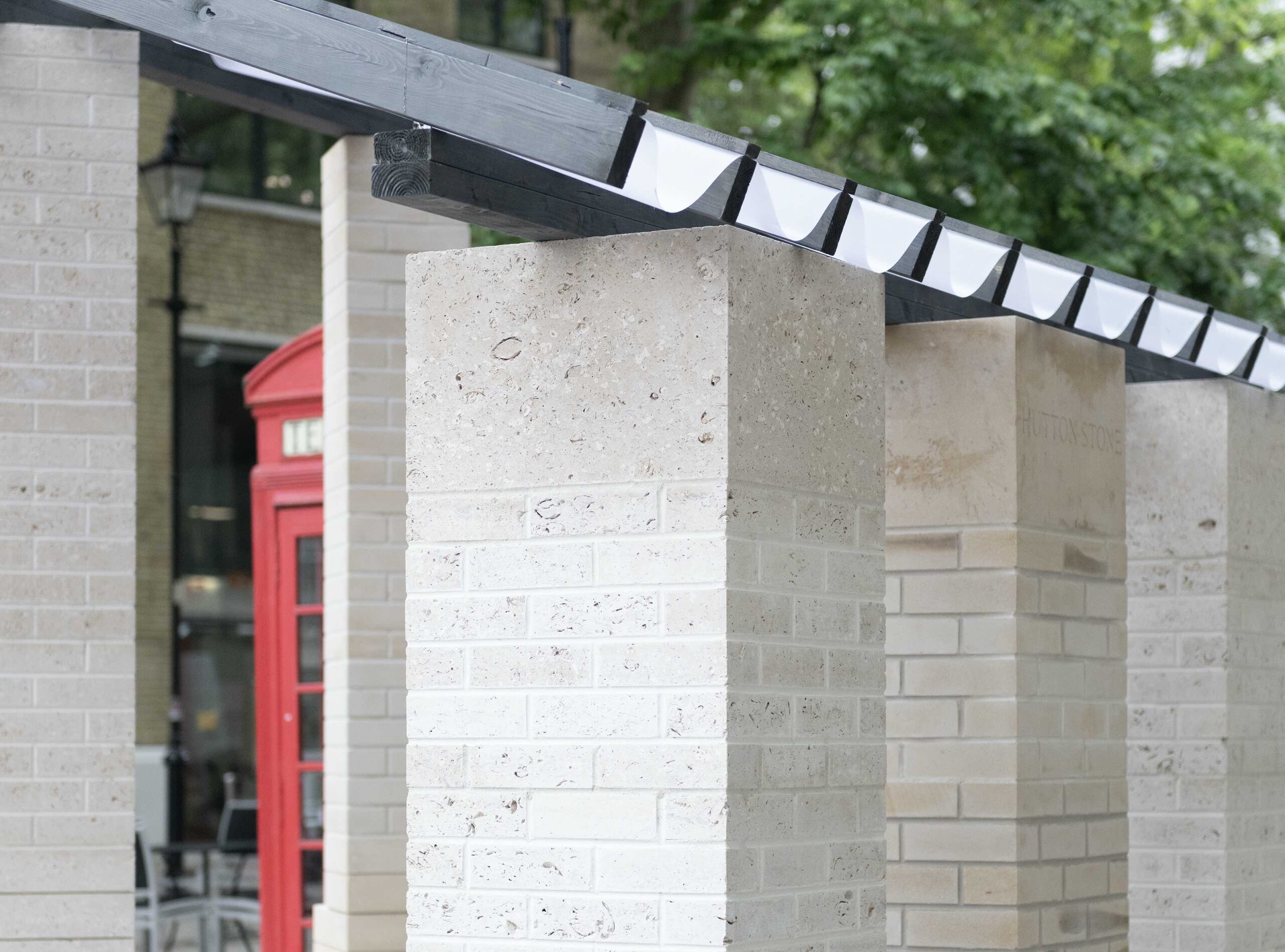London-based architecture studio Artefact has collaborated with UK stone suppliers Albion Stone and Hutton Stone to catalyse the renaissance of a once favoured and beautifully imperfect construction material
 Photography by Ivan Jones
Photography by Ivan Jones
Words by Abbey Bamford
Over the last century, stone selection and construction in the UK has been sanitised in favour of a clean and polished aesthetic, with most architects now judging the material by near-impossible standards. Perhaps that is because we see only smooth and perfect surfaces when we look at some of our most loved buildings, such as St Paul’s Cathedral and Salisbury Cathedral. However, according to Hutton Stone managing director Marcus Paine, ‘the whole of our built heritage hides some fundamental secrets from us’.
Picture one of the many churches, castles or historic town halls across the UK. Paine says they would have been built with ‘highly variable’ stone, though its imperfections are no longer visible due to ‘appropriate natural ageing through time’. This false notion of perfection from conception means that architects almost exclusively buy ‘clean’ stone, which makes up only one-third of the yield at sandstone mines such as Hutton Stone and Portland stone quarries such as Albion Stone in Dorset.
Albion Stone managing director Michael Poultney reveals that he is currently storing 30,000 cubic metres of ‘unloved’ shelly stone – enough to construct St Paul’s Cathedral. It took famed architect Christopher Wren 30 years to collate that amount before building the structure. Poultney and Paine began thinking of a sustainable purpose for this ever-growing surplus of imperfect stone, which is when the idea for stone bricks occurred.
 Photography by Ivan Jones
Photography by Ivan Jones
Traditional clay-fired bricks – which have a carbon footprint of 454kg CO2e per m3 – are the most used in the UK, with almost two million manufactured every year through carbon-intensive processes. After investing in state-of-the-art machinery, Albion Stone and Hutton Stone were able to make stone bricks with a 75% reduced carbon intensity and would be able to produce around one million bricks a year using current stock.
As it stands, Albion Stone’s Heritage Portland Stone bricks have a carbon footprint of 122kg CO2e per m3 and Hutton Stone’s Darney Heritage Natural Stone bricks have a carbon footprint of only 118kg CO2e per m3. Poultney believes that finding a profitable purpose for ‘unloved’ surplus stone will be a big driver for adopting stone brick production in his industry, while architects will be drawn to their sustainability credentials as reducing embodied carbon in buildings becomes a priority.
‘The driver for us doing it is because it’s fundamentally the right thing to do,’ says Paine. He adds: ‘When there was no cost to throwing away things it didn’t matter, but the climate crisis has given us the leverage we need to remake that argument.’ Albion and Hutton is showcasing the bricks at London’s Clerkenwell Design Week from 21-23 May through an installation designed by architecture practice Artefact.
 Photography by Ivan Jones
Photography by Ivan Jones
Titled Brick from a Stone, the installation is housed in a prime plot between Clerkenwell Green’s two iconic red telephone boxes and consists of a colonnade of six stone brick columns positioned in two rows with a roof. Three slender columns to the rear were designed to reflect the production process, with stone boulder foundations topped by slabs, strips, blocks and finally bricks.
At the front of the installation are ‘three monolithic columns emerging out of rough, solid stone plinths’, says Artefact director Daniel Marmot. Each pair of columns feature bricks from a different supplier: Albion’s Portland stone bricks, Hutton’s sandstone bricks and third supplier Polycor’s limestone bricks. Load-bearing stones were incorporated to start conversations about the material’s properties outside a brick form, as masonry stone is known to be stronger and more durable than concrete and steel, which only became popular after the Second World War, says Poultney.
Paine adds that Brick from a Stone will encourage people to consider ‘unlearning errors and assumptions made in the past’ as well as broaching the possibility of reusing stone, which is a relatively easy process if it isn’t precast with concrete. Artefact developed a series of benches and a plinth that forms a big stone table to encourage people to linger around the installation, which is situated opposite a pub. The studio also integrated a dog water bowl into one of the plinths, referencing the historic water troughs used by horses.
 Photography by Sam Frost
Photography by Sam Frost
Despite the installation spotlighting what is essentially a waste product, Artefact director Benedetta Rogers describes it as ‘beautiful’ and urges people to ‘change their perceptions of what beauty is’. She believes that ‘if you could see the embodied carbon of materials, everything would look very different’.
In the past, an architect’s biggest challenge with stone has been affordability because of the need to employ ‘expert stonemasons’, says Marmot, whereas architects can use ‘known techniques’ when working with stone bricks, removing the cost barrier. He hopes that ‘a new building vernacular might emerge’ from the stone renaissance and looks forward to seeing what kind of projects emerge as stone bricks become commonplace in construction.
The story originally appeared in ICON 215, Spring/Summer 2024. Get a curated collection of design and architecture news in your inbox by signing up to our ICON Weekly newsletter
















